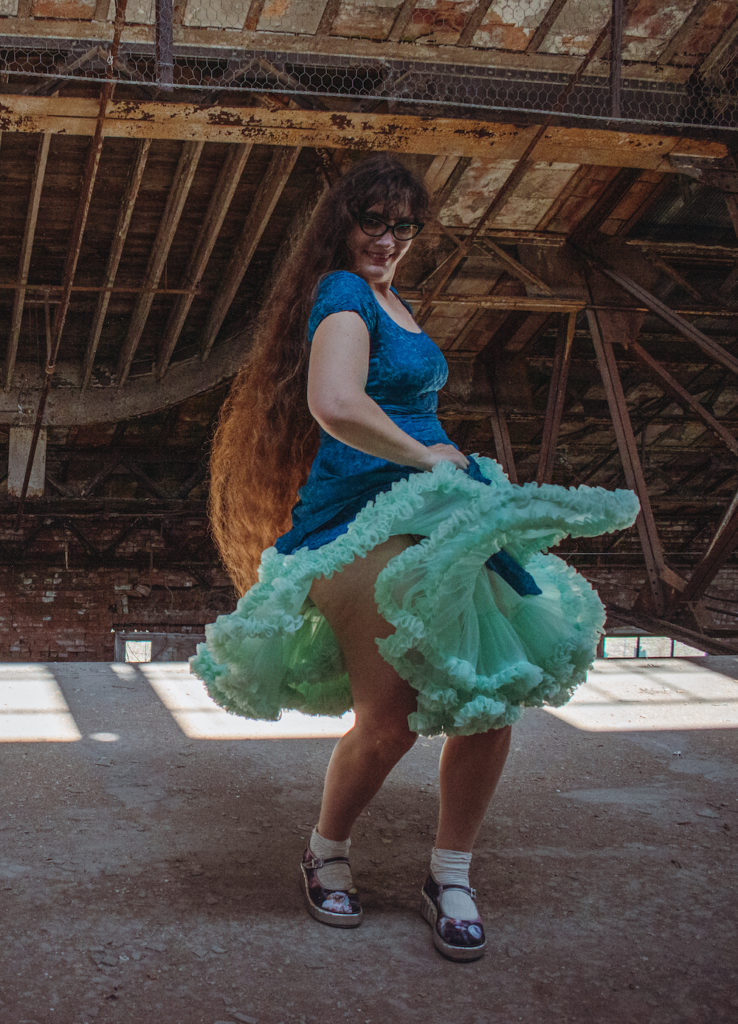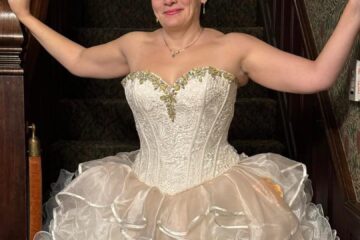A wealthy politician in jeans and a t-shirt looks like a wealthy politician in jeans and a t-shirt. Part of it is the skin. People who work outdoors, especially people with pale skin, end up with more texture to their skin. You can’t fake that texture.
We like to think we’re classless in the United States, but we also instantly recognize someone in expensive athleisure vs. Walmart athleisure. The fit is different. The fabrics are firmer on the expensive stuff, smoothing out the person underneath.
Whether I am wearing one of my handmade vintage gowns, a medieval dress, or jeans and a t-shirt, I look like what I am: an upper-middle-class middle-aged woman. I know this because of how people react to me. I don’t get chased out of stores. Police officer’s eyes pass over me without stopping.
Yet, I am also very aware of the ways in which class is advertised in clothing. When I was a teen, I hoped I could, through careful shopping and coordination, make myself “popular.” Or at least “pretty.”
Fun fact: we code class in popularity and attractiveness. To dress poorly is to dress poor.
I was picked on a lot for my clothing, and once, when a girl snarked that my skirt didn’t go with my shirt, AGAIN, I was too frustrated to simply take the abuse. I asked her, “please just tell me how to do it. I’m trying. I thought earth tones with earth tones was okay. I know not to mix patterns and which colors clash but I’m still failing. Tell me how. How did you match that top and skirt that you have on?”
She blinked, took a step back, and said, “These… were sold together.”
And that is that. To dress middle-class, go to middle-class stores and buy the outfits that are sold together at middle-class prices. If you can’t afford to buy ready-made outfits, you end up having to have a PhD in fashion. (Yes, still bitter.)
No one wants to be “a type.” We think that we’re expressing something very unique, but chances are, if you look back on photos of yourself from ten to twenty years ago, you’ll be shocked how un-unique you are. (It needs the time for separation, and also for other people to be in the frame for comparison.)
There are constraints to your fashion choices, some of which are invisible to you. What is available in your area? It could be constrained by what companies have the shipping contracts, what avenues for transportation there are. Yes, you could buy online, but do you have broadband? Can you afford to wait for the delivery? Is your doorstep a place a package will stay? Also, what can you afford, in money? What FITS you? What are the cultural constraints that taught you that, say, you HAD to wear jeans every day?
How do sub-culture costumes fit in this? Iconoclasts? There ARE people who want to be a type, who deliberately choose to dress to a model. The metal head. The anime girl. You know what I mean when I say my dad was a hippie – I am not just talking about his politics and music tastes.
My kid went through a goth phase (only they don’t call it goth anymore it’s emo now but you KNOW it’s the same thing.) Black clothes, heavy eyeliner, jewelry from the Halloween sale. She got picked on. Why did she choose to dress in a way that attracted negative attention?
Why did I “choose” to match a brown faux-suede skirt with a tan-and-brown striped blouse from the Goodwill?
It seems like one decision was more limited than the other, but having been up close to many goths, including my own twin sister, I can say that to the goth, goth isn’t treated like a choice. He has to wear heavy black eyeliner and dye his hair purple. She has to balance of the pain of being picked on verses the pain of giving up something that makes her happy, that forms a part of her nascent identity. Like the aposematism of bright red bugs, they have to be flashy to show they are not to be eaten. The goth kid aposematism stops their identity from being eaten by the conformity of their community.
Or, I suppose – if you find yourself not quite able to fit in, it’s emotionally less painful to not fit in purposefully than suffer the thousand slings and arrows of “that skirt doesn’t go with that top.”
This sort of dress choice has a class, too. My twin sister was a goth in high school, but no one would have known it, because her “goth” wardrobe was simply selecting everything we had that was black (in various faded shades.) In college, when she had a job and ready money, she was able to buy black bows and make chain mail accessories for herself. She became visibly goth because she had the funds to do so, but she was always “black on the outside because black is how I feel on the inside.”
Even when we think we’re dressing outside of society – the goth, the lolita, the ren fairy – we are showing our class status in how well we can achieve those sub-cultural standards. The full fur suit wearing furry has more free time and money than the person with a fox tail and ears on a headband.
I wanted to believe that skill could take the place of class, that by learning to sew and match fabrics, I could elevate my personal beauty in the eyes of the world, but even skills are a sign of having free time to work on them.
If this post feels like a downer, I apologize. I don’t feel bad about looking like an upper-middle-class suburbanite. There’s freedom in knowing that you will always look like yourself. I can stop worrying about THAT.
Though I do feel, after a lifetime of study, I could give young-me better advice on passing for well-off. A more careful exploration of the Goodwill, leaning into vintage instead of just-out-of-fashion, for example. Splurge on key pieces – a really good pair of jeans to pair with old t-shirts will make the t-shirt look ironic and intentional. Keep separates neutral – black or grey or denim for skirts so you don’t have to worry if a particular shirt will match.
But I digress. It is a gift, to be able to be seen. So see me, see my cellulite, see my shape as it really is, not how I want to make it look by twisting at the waist and raising my chin… see my comfortable life. I earned it.



